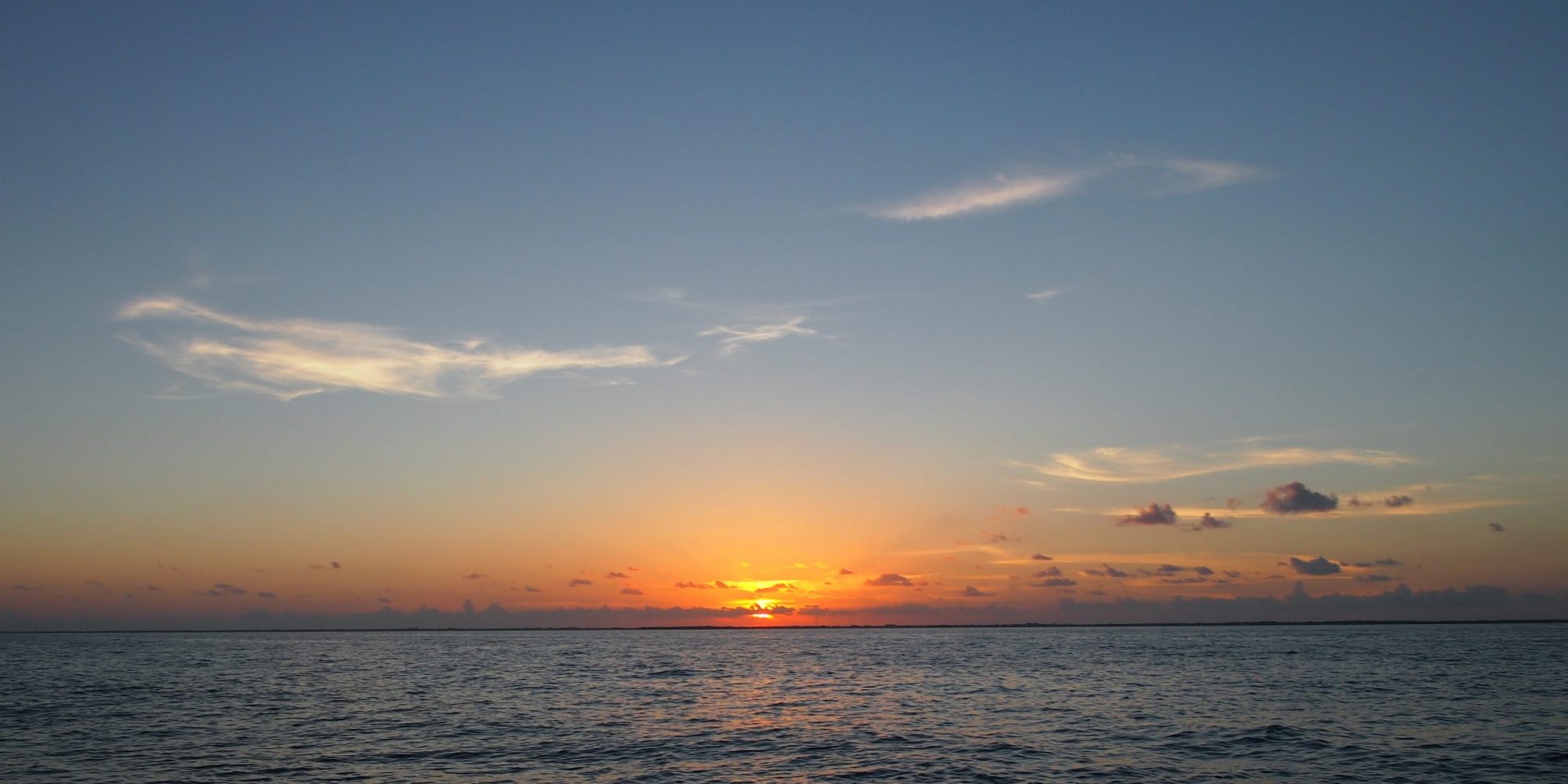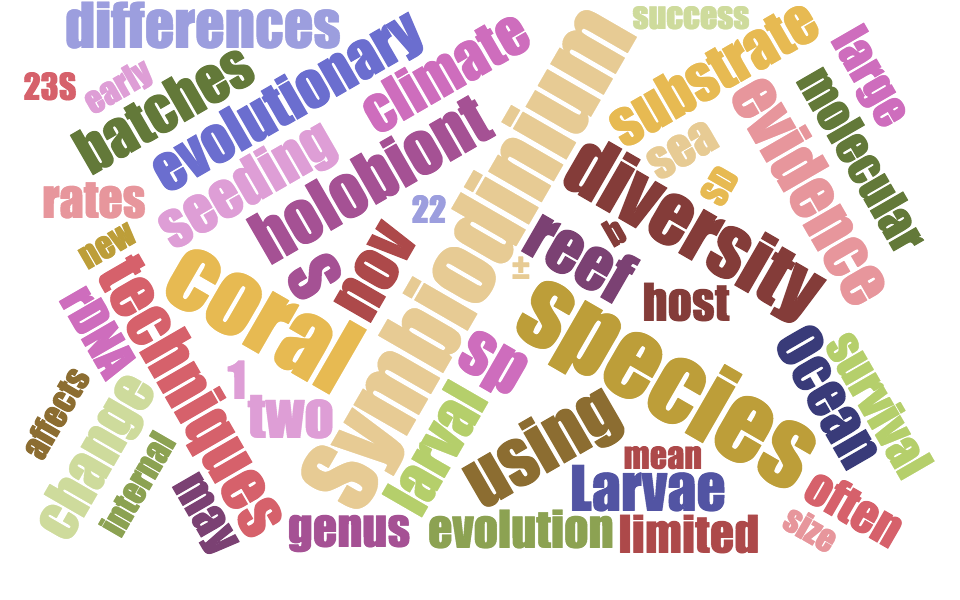I have many research interests: coral reef ecology, climate change, symbiosis, genotype interactions, larval dynamics, reef restoration, molecular biology, evolutionary biology, physiology, population genetics, bioinformatics, phylogenetics, species delineation, speciation, and transcriptomics. For more details, read on!
- Background | Launch
- Species Delimitation in Symbiodiniaceae| Launch
- Genotype Effects in Isolation | Launch
- Genotype Interactions | Launch
- Artificial Common Gardens | Launch
Current Interests
Here is a word cloud based on the text of several recent papers, with the most frequent phrases given the largest font size:
Corals are symbiotic marine animals that associate with microalgae. These photosynthetic dinoflagellates live within the host tissue and provide much of the energy corals use for daily function and skeletal growth. Without the algae, reefs wouldn’t be as productive, as multidimensional, or as colorful as they are today. Unfortunately, as the oceans warm and sea surface temperatures increasingly become stressful, the symbiosis can break down and corals bleach, losing most of their algae. Bleached corals are more susceptible to disease, and can effectively starve without their symbionts. If corals lose symbionts, reef environments lose corals, the structure they provide, and the amazing biodiversity they support.
My goal is to use molecular techniques such as DNA genotyping and genomics to examine the ecology of the coral-algal symbioses, particularly under stressful conditions associated with climate change. Using next-generation techniques, I can uniquely identify both partners of the association to the individual level, and track how interactions between particular individuals influence important biological functions like growth rates, photochemistry, and gene expression under various conditions, such as those associated with warming oceans. Hopefully understanding such genotype x genotype x environment interactions between corals and microalgae will help inform the management strategies of coral restoration workers at nurseries throughout the Caribbean.
Species Delimitation in Symbiodiniaceae
The unicellular, endosymbiotic dinoflagellate microalgae that associate with corals belong to the family Symbiodiniaceae (more commonly, they are known as ‘zooxanthellae’). Under a microscope, they resemble tiny golden balls, with very few distinguishing morphological features. Early on, this led scientists to believe that Symbiodiniaceae consisted of one globally-distributed species. Using modern molecular approaches, we now recognize that there is a tremendous amount of diversity within the group. Certain lineages perform very differently from others, filling separate ecological niches and responding to stressors in unique ways.
Despite the widespread recognition of this diversity, there are still only a handful of formally described Symbiodiniaceae species. The rest are referred to by alphanumeric characters, and many labs have different names for the same entity. To avoid confusion, I have been promoting the use of a hierarchical molecular classification scheme to delineate species of Symbiodiniaceae and assign them fixed Latin binomials. This involves the sequencing of several independent regions of the genome that evolve at different rates, and checking that members of each species are consistently grouped with each other, indicating genetic boundaries. Additional layers of evidence, such as ecological diversification, can support the molecular data. Hopefully the use of a common nomenclature will make it easier for Symbiodiniaceae researchers to communicate results with one another and encourage others to join the field.
Taking a reductionist approach to studying the coral holobiont—the combination of the animal and its algae (and its microbial community, which I don’t currently study)—the first step is to examine each partner in isolation. To look at the host, my lab has traveled to Mexico and Puerto Rico during the annual mass spawning of the Elkhorn coral Acropora palmata. In this species, recently-released sperm and eggs lack symbionts. By performing controlled crossed between different parents and growing the resulting larvae under different thermal regimes, we found that certain parent combinations are relatively incompatible, and a given larva’s performance during heat stress depends in part on who its parents are.
To get at the symbiont’s influence, I maintain a large repository of algal cultures—monoclonal strains of Symbiodiniaceae dissociated from corals and growing in tubes. In the lab, I can manipulate temperature and light conditions and monitor how different individuals within different species respond. This work is in the early stages, but already I have found that in terms of growth rates at elevated temperatures, certain genotypes can be more similar to members of other species than to other genotypes within their own species. Taken together, these results indicate that genotype-level effects are ecologically relevant for both the host and symbiont in isolation, which strongly suggests that their interactions in the combined holobiont are significant, as well.
To truly tease apart the contribution of the host and the symbiont to holobiont performance, it is necessary to study combinations of both partners, especially where one member is controlled and the other is allowed to vary. A unique group of corals in Mexico presented such an opportunity. In these particular individuals of Acropora palmata, distinct hosts were all associating with an identical symbiont genotype. I exposed fragments of the colonies to stressful temperature conditions, and recorded the symbiont’s photochemical efficiency. This particular strain had very different efficiencies depending on the host genotypic background.
During the same experiment, I preserved RNA from each fragment and hybridized it to a microarray designed for this coral species. I got a snapshot of how genes were being regulated in each colony during the temperature stress. By grouping colonies based on the variable efficiency of the symbiont they were associated with, I can see exactly which expression profiles characterize an efficient holobiont versus an inefficient holobiont, all while controlling the symbiont genotype. The results have highlighted the importance of cell-cell signaling pathways and transport vesicle formation for a healthy symbiosis, and demonstrate that genotype by genotype interactions are ecologically meaningful in the wild.
Two Caribbean species, the Elkhorn coral (Acropora palmata) and the Staghorn coral (Acropora cervicornis) are currently listed as threatened under the Endangered Species Act and have been targeted for restoration. Several coral nurseries have been established in the United States and abroad, where corals are fragmented, propagated, and ultimately outplanted back onto the reef. During their time in the nursery, fragments are grown right next to each other under identical conditions. Such a common garden effectively removes environmental variation. Despite this, certain colonies tend grow much faster than others, and we can attribute such differences to genetic influence.
I have genotyped the hosts and symbionts from several holobionts in many nurseries, and have begun correlating genetic diversity with growth rates, bleaching incidences, and mortality levels. In many cases, a number of corals are sharing identical symbionts in the common garden, and yet they grow at very different rates. Such observations again suggest an important role for genotype by genotype interactions on ecological time scales. Ongoing thermal shock experiments with fragments from these nurseries will hopefully give us a better sense of the degree of standing variation in the population with respect to thermal stress response.

